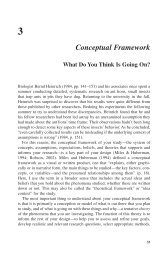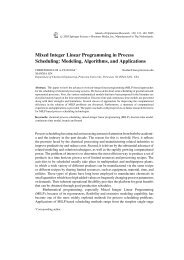Qualitative Research Basics: A Guide for Engineering Educators
Qualitative Research Basics: A Guide for Engineering Educators
Qualitative Research Basics: A Guide for Engineering Educators
You also want an ePaper? Increase the reach of your titles
YUMPU automatically turns print PDFs into web optimized ePapers that Google loves.
3. Designing the Study<br />
Designing a qualitative study is similar in many respects to other types of studies, yet<br />
different in some key ways. Like quantitative studies, one must identify the research<br />
questions of the study, align the data collection methods with those research questions,<br />
and consider the appropriate population to study. However, qualitative studies have<br />
additional considerations, such as the epistemological perspective that underlies the study<br />
and the role of the researcher in both data collection and analysis. This section will<br />
describe the major characteristics of qualitative design and elements that should be in a<br />
study proposal, such as decisions about data collection, sampling, Human Subjects, and<br />
ethics.<br />
Characteristics of <strong>Qualitative</strong> Studies<br />
As Chapter 1 described, in accord with the epistemological assumptions on which they<br />
rest, qualitative studies have the following design characteristics:<br />
Naturalistic orientation: The studies are almost always conducted in the natural<br />
setting, rather than under laboratory conditions. They do not normally rely on<br />
interventions or manipulations, but seek to understand existing conditions.<br />
Purpose: The studies are not primarily aimed at prediction, control, or<br />
generalization, but rather understanding, and in the case of critical studies,<br />
critique.<br />
<strong>Research</strong>er involvement: In qualitative studies, the “researcher is instrument,”<br />
an essential lens through which the reality of the participants is documented. The<br />
researcher’s presence is acknowledged and his or her engagement is regarded as<br />
an asset rather than a contaminating factor.<br />
Holistic perspective: Rather than isolating variables, the researcher is interested<br />
in looking at things in context and noting the patterns of interaction and change.<br />
Unique case orientation: Depth is more important than breadth; individual<br />
characteristics are the focus rather than attempts to find the “typical” or to make<br />
statistical generalizations.<br />
Inductive approach: The researcher works from particulars to patterns, not from<br />
theories to specific cases. The approach is exploratory rather than confirmatory.<br />
Theory is generated rather than tested; explicit hypotheses to be tested are not<br />
<strong>for</strong>mally developed be<strong>for</strong>e the study begins.<br />
16
















